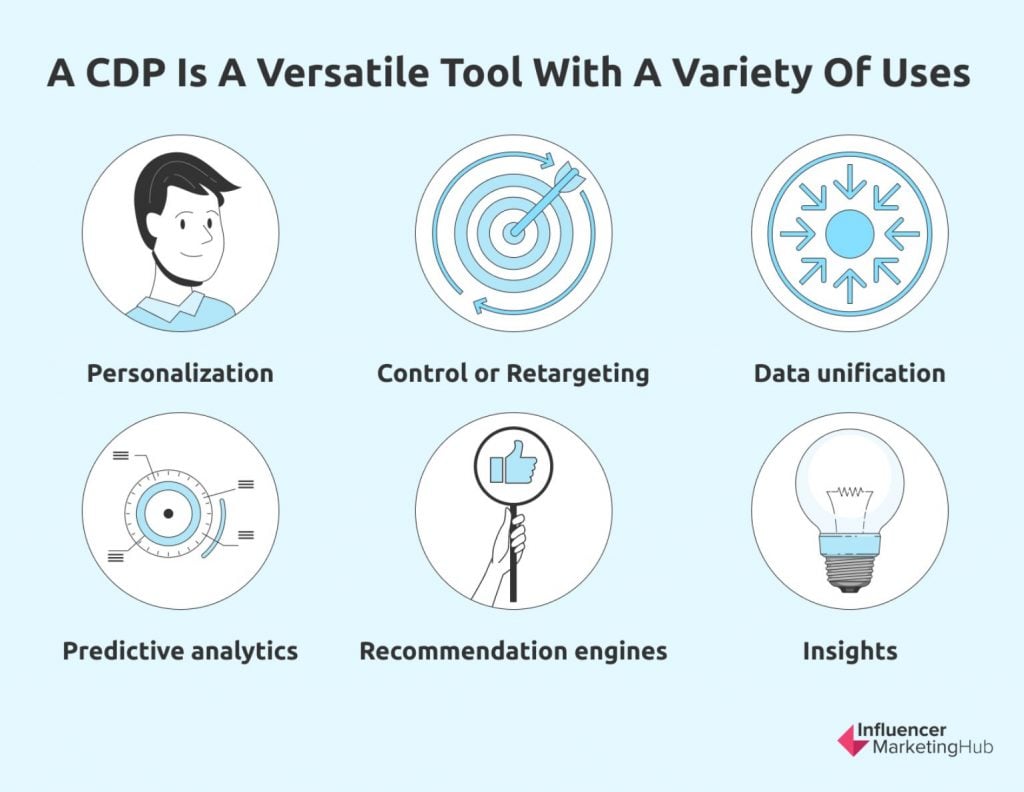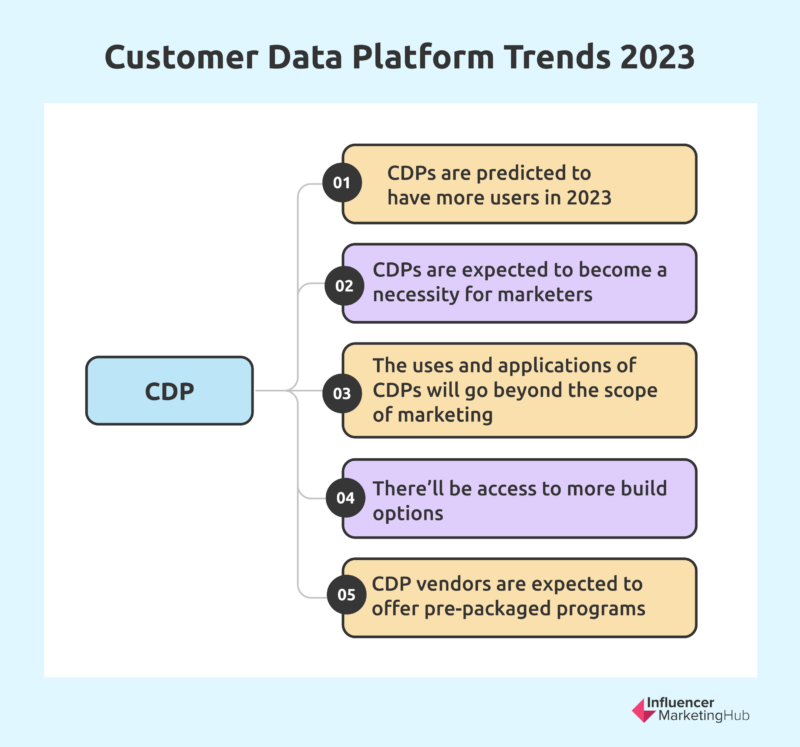A customer data platform (CDP) is software that enables businesses and marketers to optimize their data by creating a unified and centralized customer database. This database contains all data from various customer touchpoints and allows for segmentation, which is critical for creating personalized marketing campaigns.
It eliminates traditional data silos that limit how you can utilize your data or render your customer analytics pointless. These silos also prevent companies from creating consistent experiences for their customers across different channels and platforms.
A CDP has several uses and benefits. Some of its use cases include data unification, better control or retargeting of customer profiles, predictive analytics, and being able to leverage different data types collected from various sources.
Its benefits include the capacity to provide organizations with a single view of the customer, letting them collect data from multiple sources and create a more comprehensive view of each customer. An AI customer data platform also enables companies to be more flexible and agile by providing them with information they can use anywhere. Being flexible and agile also lets them meet changing consumer behaviors and demands.
Moreover, when you have a CDP in place, you’d be able to leverage customer data better and make it more accessible to constituents who need the information for launching campaigns, analytics, and customer service.

Source: nealanalytics.com
A good customer data platform evolves to accommodate changes in tech, use trends, and consumer behavior. In this article, let’s dive into the emerging trends that will shape CDPs in 2023 and find out what you can do to optimize how you apply CDPs within your own organization. If you want to find the best CDPs for your business, check out our article on the Top 30 CDPs for 2023 for information that can help you jumpstart your journey into the diverse world of customer data platforms.
Customer Data Platform Trends to Watch Out for in 2023:
Customer Data Platform Trends for 2023
Over the past two years, the CPD industry enjoyed significant growth. This growth is, in part, attributed to the increase of industry vendors, share of employment, and share of funding. Given its recent growth, some experts predict that with the increase in marketing budgets and hiring, CDPs will play an even bigger role in organizations and businesses, as marketers are starting to adopt CDPs into their tech stack.
With this growth and with the digital transformations brought on by the pandemic, you can expect to see several trends that will shape CDPs and their use cases in 2023. As technology continues to evolve, businesses and marketers need to stay aware of such developments, as this allows them to make more informed decisions when it comes to choosing the right CDP for their needs.
With this in mind, let’s look at five customer data platform trends for 2023.
CDPs are predicted to have more users in 2023
In the digital age, there’s a wealth of data that companies have to deal with. Businesses are now collecting different types of information about their customers from multiple sources and various touchpoints.
For smaller companies with a limited marketing stack, being able to leverage data to learn more about customer behavior and determine their needs is relatively easy. For larger businesses that offer a variety of products, have multiple marketing channels, and have a wide customer base, leveraging customer data can be challenging.
A CDP is an integral tool that enables businesses to have a centralized database of all their customer data. They can then use the insights generated by CDPs to craft more targeted and engaging marketing campaigns.
Because CDPs are powerful and versatile, it’s not only marketers from large organizations who can benefit from the use and application of CDPs. Different teams, such as finance and IT, and businesses of varying scales can use CDPs to come up with more informed solutions and actionable insights for areas like services and products.
Considering the powerful capabilities offered by CPDs, it’s a pretty safe bet to say that in 2023 we’ll see many more marketing teams incorporating it into their tech stack. Plus, if the industry’s revenue growth over the past few years is anything to go by, there’s an exciting future in store. According to data shared by Statista Research Department, in 2022, the CDP industry revenue grew by a massive 25% to reach the $2 billion mark.
CDPs are expected to become a necessity for marketers
Marketers have access to a variety of customer data collected from disconnected platforms. As we’ve already established in the previous sections, a CDP can bring together all the data you’ve collected to create a centralized database in real time.
With a CDP, you’d be able to have a more comprehensive view of each customer’s behavior and their history or buyer’s journey. This, in turn, gives you a more intimate look into each customer’s experience and what factors contributed to their transition from leads to conversions.
Furthermore, a CDP improves campaign segmentation, which paves the way for personalized content and improved customer engagement. By adopting a CDP that’s easy to use, reliable, secure, compatible with your existing tools, and has robust activation, automation, and measurement tools, you can better automate and streamline your marketing processes.
With the challenges surrounding data privacy and transparency, there’s a need to focus on improving how you collect, manage, and use first-party data. There’s also a pressing need for marketers and businesses to be able to fully utilize all the data they’ve collected. CDP aids them in creating a more sustainable practice when it comes to data handling and distribution.
More than adopting so-called “vanity metrics”, or metrics that look good on a surface level and aren’t particularly meaningful, like page views and the number of followers, having a tool that can accommodate changes in data privacy and can give you actionable metrics is essential for marketers moving forward.
The bottom line is, given its capability to improve segmentation and for crafting optimized, targeted campaigns, CDPs can help businesses produce more engaging and value-adding customer experiences and relationships in the long run.
The uses and applications of CDPs will go beyond the scope of marketing
Customer data platforms and customer data aren’t just relevant to marketing departments. They’re also widely used by sales teams, customer success managers, and IT departments, among other constituents.
Making customer data accessible to all relevant departments is crucial in achieving a thorough understanding of your customer’s behaviors, needs, and preferences. CDPs give a unified view of customer profiles, which is integral to omnichannel personalization.
For example, corporate IT departments play a role in deploying CDPs. As CDPs are increasingly being integrated with other systems, it’s expected that IT departments will play a bigger role. If CDPs are being adopted across various enterprise-wide systems, then organizations’ CDP requirements should also change.
Flexible, versatile CDPs are capable of handling larger volumes and types of data. They should allow a more seamless connection between different systems, particularly the source and destination systems. New CDP requirements should also include a CDP’s capacity to support a larger volume of analytical processes and ever-evolving standards when it comes to security and performance.
If you’re thinking of adopting CDPs for your organization, you need to factor in its capability to orchestrate customer experiences across different channels. You also have to think about the different departments, like operations, marketing, and IT, where the responsibility of providing customer experience overlaps. Your CDP should also be able to integrate with your existing tech stack, as this can enable you to better optimize and fully utilize data across different departments.
Even if you already have a flexible CDP that can meet the different needs of every department, you shouldn’t overlook its ease of use. Remember that CDPs aren’t just intended for developers, which is why it’s important to go with a CDP that’s user-friendly. This expands its use and application within your organization instead of its functionality being restricted to your IT department.
There’ll be access to more build options
As the use and application of CDPs continues to grow in scope and as business needs change, it’s highly likely that this will push enterprises to create their own solutions, specifically an equivalent for CDPs. This has pushed software companies to come up with digital solutions that are geared toward enterprise IT departments.
To keep up with this shift, CDP vendors are working toward creating CDPs that have more build options. There’s a need to integrate different processes and solutions, such as customer experience orchestration capabilities and the need for real-time access to data and analytics. This spurs enterprises to adopt solutions that combine CDP functionalities for specialized processes and software with data management components.
Also, it’s expected that with more build options and heavier demand for more complex capabilities come more buy options. You can expect more vendors to offer CDPs that are designed for particular industries like health care and financial services.
CDP vendors are expected to offer pre-packaged programs
One of the greatest challenges of enterprises is being able to fully utilize data generated by or collected from CDPs. This is due, in part, to issues in CDP deployment and the lack of individuals who are capable of operating and utilizing CDP data.
To address the issue of data utilization, many vendors have started to offer pre-packaged CDP programs, which include features like content templates and process flows.
It’s worth noting that trends can change. While they may serve as a guide for the direction that CDPs will probably take in the coming years, they’re not 100 percent accurate. Also, these trends shouldn’t take away the fundamental role that CDPs play in data collection and management.
Furthermore, regardless of trends, it’s highly likely that CDPs can drive an organization’s agility. For example, by leveraging customer data platforms that have artificial intelligence and machine learning capabilities, enterprises can swiftly make informed decisions and take action on emerging or key industry trends.
When finding CDPs, you first need to determine what your marketing goals are. From there, focus on finding a CDP that’s capable of helping you meet your goals faster and in a more efficient manner. This enables you to stay on top of things, even as consumer behavior or trends continue to change.
6 CDP Capabilities to Keep an Eye Out For
Customer data platforms enable companies to turn customer data into actionable insights. However, CDPs, and their features, can vary from one vendor to another. When finding CDPs, you need to look for six key features, which are: real-time behavioral insights, single customer view, personalization, testing and optimization, privacy, and security.

Source: emarketer.com
Aside from six key features, you also have to look out for six key capabilities of CDPs, which are:
Capacity for customer data management
Businesses constantly deal with large volumes and different types of data from several sources. This includes offline data.
Not all CDPs are built the same—some are capable of pooling together data from various sources. However, not all CDPs are able to do so. When finding the right CDP for your enterprise, you first need to first consider the types of data you need to collect and leverage.
Ability to provide identity resolution
Customers have high expectations of businesses. They believe that the latter should be able to identify and treat each customer as a distinct individual. As such, it’s crucial for CDPs to be able to sort out customer identities to enable you to avoid or resolve issues with consumer identity.
Capability to carry out identity matching across various channels
The work doesn’t end with a CDP’s ability to resolve any confusion when it comes to customer identity. Your organization also needs to be able to match customer identities across different touchpoints, channels, and data applications. If you’re unable to resolve and match customer identities, this may put you at risk of putting forward duplicate campaigns or irrelevant offers.
Persistent tracking of customer behavior
Each customer has a different set of preferences, and this applies to products, services, price points, and even platforms or channels. A CDP should be able to deliver continuous omnichannel tracking of customer behavior. This enables you to get data and insights on things like the factors that likely influence their purchase decisions or the channels they’re most likely to engage with.
Customer analytics
There’s no denying that analytics are crucial if you want to better understand your customers and their behavior. However, being unable to fully utilize your analytics can prevent you from creating compelling campaigns or making immediate decisions according to changing consumer trends.
An excellent CDP is capable of combining the functionalities of AI, machine learning, and other analytic tools to provide you with easy-to-understand and easy-to-interpret models that can help you gain insight on your customer’s preferences, buyer’s journey, and purchase history.
Capabilities for orchestration
A good CDP should be equipped with orchestration capabilities that allow you to process customer data and other information in real time. This enables you to swiftly address changes in customer behavior or consumer trends.
Observing Trends as a Guide for CDPs in 2023
Today’s marketers have access to an array of tools that promote digital transformation. Aside from solutions like Google Analytics and split testing, CDPs are one of the important components to consider when implementing digital transformation within your organization, particularly in marketing.
You can think of CDPs as a worthwhile and strategic investment in the coming years.
As access to third-party data continues to be reduced, the need to be able to utilize first-party data is growing. The current trend in data collection and management is slowly moving away from the traditional model, which relies heavily on third-party data for marketing campaigns. Being able to adopt CDPs as early as now can let you better manage and control all the first-party data you’ve collected.
Also, with the growth of online activity, organizations are expected to work with varying volumes of data gathered from multiple channels. You can expect to see CDPs being used across different departments that overlap when it comes to providing customer service and ensuring the delivery of engaging customer experiences across different channels.
With personalization driving the need to change the standards of customer experience, CDPs are an invaluable asset for any company to have. The good news is that CDPs are continuously being improved to accommodate the changing trends for the foreseeable future.
Frequently Asked Questions
What are the critical components to look for when finding customer data platforms?
A CDP should be capable of ingesting and processing data in real time. It should also be able to accommodate changing data volumes.
You’d have the capacity to update its data controls in real time, allowing you to better optimize and work with varying data volumes. Furthermore, a good CDP is capable of long-term storage at a granular level. This ability to store historical data enables you to utilize data you’ve previously collected.
How can I begin selecting the right CDP for my organization?
When choosing a CDP, you need to consider your industry and determine the CDP’s use cases within your niche. Identify what your goals are and organize them according to their priority. Would you want a full understanding of the customer journey or to create targeted online experiences for your customers?
Then, consider its features and whether or not these can support the use cases you’ve identified. Also factor in what your other requirements for it are. Do you want to focus on GDPR and CCPA compliance? Do you need to prioritize data protection and security?
Once you’ve determined your other requirements, you can start comparing CDP vendors. With the multitude of providers available today, it can be difficult to find a CDP that’s suitable to your industry and addresses your particular set of needs. To make the selection process easier, check out the CDPs that are being widely used within your industry.
In the process of finding a CDP, it’s important to meet with the potential stakeholders, or teams or departments involved with data collection, management, and use or distribution. This is because you’ll be working with data sourced from various departments.
What other benefits can CDPs offer?
Aside from unifying all your customer data, CDPs are capable of eliminating data silos, and this, in turn, can help make your organization more efficient and agile. Moreover, your marketing campaigns and customer experience can benefit from the use of CDPs, given that they’re able to generate comprehensive, reliable data that you can use for segmentation and in creating more relevant and engaging experiences for your customers.
Another benefit of CDPs is their ability to establish security and trust, as CDPs are capable of providing users with the ability to limit access to personal information to only authorized platforms or channels.




